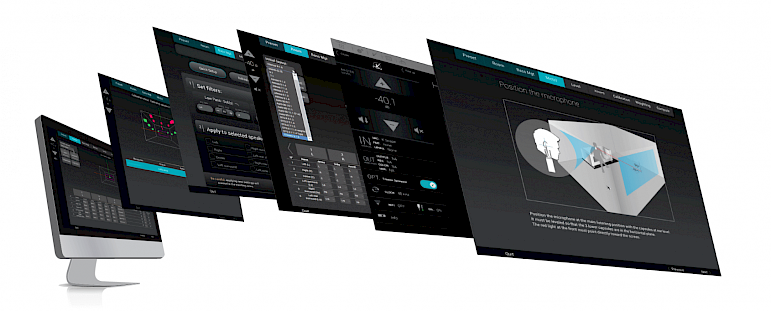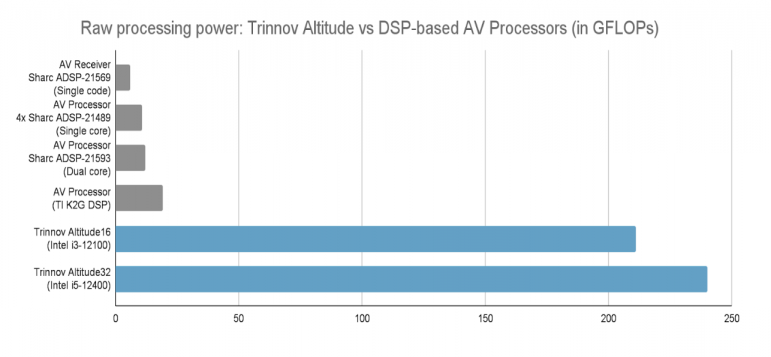Flexible Architecture
Historically, the decoding, processing and operating functions of an AV Processor have been distributed across multiple, specialized DSP chipsets, in rather complex and rigid architectures.
These architectures are developed and made available to consumer electronics brands by a handful of OEM manufacturers. In a market that is driven by fast-changing technologies, this approach inevitably leads to short product lifespans and early obsolescence. Unfortunately, this paradigm is ubiquitous… except for Trinnov’s unique Processor range.


Trinnov’s design philosophy is built around dual architectures:
- The Audio section handles fundamental audio functions with dedicated, high-quality Trinnov hardware. Such functions include audio clocking, hardware routing and conversion. The audio section effectively manipulates audio inputs/outputs and transmits audio data to the processing section.
- The Processing section is technically an embedded computer running Trinnov’s custom operating system optimized for audio application. The processing section includes and leverages multi-threaded, multi core processing and built-in network. This is mostly where the Trinnov magic happens: advanced high-resolution processing and decoding.
This clear separation and architecture is what makes Trinnov products so robust, so resilient and so scalable.
Trinnov OS
When it comes to using computers for audio applications, the facts speak for themselves.
For more than a decade, all the audio and video content has been produced on computers: digital audio workstation, video editing, CGI…even the most analog music studios record into computers.
When it comes to reliability, let’s also remember that the internet runs on computers 24/7 and most of it runs on Linux.
Ever since Trinnov started developing audio technologies, everything has been designed and developed under Linux, which offers an unrivalled level of customization. We created our own operating system, optimized for audio applications, reliability and performance. Trinnov Processors have run 24/7 for more than a decade in the most critical and sensitive facilities: commercial cinemas and studios.
Continuous development
By choosing to work with CPUs, rather than fixed DSP chips, Trinnov can implement and release new software features rather than replacing expensive hardware.
Our products receive regular security and system updates seamlessly, whilst we keep adding new exclusive features to improve sound quality across a wide range of applications.
All of the above is done whilst keeping control over what is being delivered to our clients and how any feature is being implemented.
This level of flexibility ensures Trinnov maximum control over the development and the quality of its products.
Sustainable Investment
“Buy once, cry once” refers to the purchase of an expensive but durable item, with no regrets.
Our software-based platform ensures that we can live by this commitment and keep adding value to our products over a longer period of time than any of our competitors, building long-term relationships and trust.
Among such achievements, we can name but a few: free addition of DTS:X Pro, public release of WaveForming as a free software update, 4 additional processing channels unlocked free of charge…
We are proud to say that this commitment is both unique and set to continue.
Why is processing power critical?
Since the introduction of Immersive Sound and high channel count, it became obvious that processing power is the most critical feature of a high-performance audio processor.
This is even more true today as high-end processors must simultaneously support high-resolution audio (96k and 192k), high channel count rendering and upmixing (up to 35 channels), as well as advanced Room Correction and Active Acoustics.
This raises questions: how do high-end AV processors deal with these demanding processing requirements? What is the impact on audio quality? And what headroom remains for future processing-intensive technologies that will inevitably happen?


Raw computational power
The objective measure of processing power for any audio or AV Processor is given in GFLOPs, which stands for Giga Floating Point Operations per Second (one GFLOP equals one billion floating point operations per second).
The computing power available in DSP-based and CPU-based platforms is drastically different, to the CPU's advantage.
As of early 2025, the most powerful DSP-based platforms available peak at around 20 GFLOPs of audio processing whereas the Altitude16 delivers a processing power of over 200 GFLOPs conservatively (this can double with features such as Intel Turbo Boost).


In other words, an Altitude16 benefits from a computing capacity of at least 10 times greater than the most powerful DSP-based processors on the market. This striking difference only increases with the Altitude32, but also with any Trinnov processor over time and with the release of more recent processors.
Other parameters should be taken into account and also heavily weigh in CPU’s favor:
- Internal, or cache memory, is vastly superior and faster on CPU, improving processing such as long FIR filters and real-time audio in general.
- Expanded external memory to allow for very complex algorithms with many instructions and/or minimizing computation time.
- Less programming complexity, less latency and overhead.
To summarize, it’s fair to say that in most practical cases, a single processor outperforms a DSP processor array, even with the same theoretical processing power.
The only downside is that High-performance CPUs are much more expensive than DSPs designed for consumer application. This includes even the most powerful embedded DSP platforms such as the Texas Instrument K2G which uses 2 ARM Corex-A15 core and a C66s DSP.
High-Resolution Processing
The extra computing power and memory available from CPUs make advanced processing possible for a high number of channels, without major limitations in terms of implementation and resolution.
Processing power is so critical that manufacturers have no choice but to accept significant compromises in the implementation of new technologies:
- Limit the number of rendered immersive sound channels (ex: 24 instead of 35, limiting the spatial resolution).
- Limit the FIR filter length to 3000 taps or even less.
- Give up high-resolution audio processing with systematic downsampling of the audio
- Use single-precision 32-bit floating point operations.
- Exclude some loudspeakers from digital room correction or active acoustics processing
In contrast, our CPU-based platform has no such limits and uses 8000+ taps in our FIR filters by default, with the ability to increase all the way to 32 000 taps at 48kHz and 130 000 taps at 192kHz as required.
64-bit Floating Point Processing
More importantly, our platform processes audio with 64-bit floating point resolution. This is the resolution used in studio mastering of the music and movies you listen to for good reasons:
- Increased precision: especially useful when dealing with subtle changes or very quiet sounds that need to be preserved in high-quality processing.
- Higher Dynamic Range: using 64-bit virtually eliminates the risk of clipping during processing.
- Better Headroom: there’s more space for calculations before running into overflow or distortion, which is critical when performing many complex operations that could otherwise cause 32-bit values to distort or lose precision.
- Reduced risk of Rounding Errors, which can accumulate over time, especially with repeated calculations.
The result is an unmatched level of audio accuracy and transparency, enabling us to process audio without degrading or losing the original information.
Ready for the future
DSP-based AV processors must use many processing tricks to deliver the latest available audio processing technologies. The question becomes: What processing headroom is left for future signal processing technologies, knowing that they will probably be even more processing-intensive?
The benefit of the Altitude platform and its CPU-based architecture is obvious: not only does it avoid the necessity of these Memory/GFLOPs-saving tricks (and associated audio compromises), but it also preserves significant processing headroom to handle future more demanding processing algorithms.
This makes the Altitude processors the processor of choice for long-term, sustainable high-performance installations.







